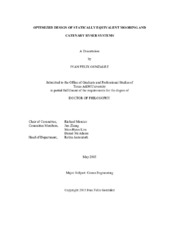| dc.description.abstract | Due to size limitations of wave basins worldwide it is necessary to employ statically equivalent truncated mooring and riser systems to test floating systems to be deployed in deep and ultra-deep waters. A procedure for the optimized design of the statically equivalent truncated mooring and riser system was developed using a Genetic Algorithm, considering that the equivalent mooring/system needs to reproduce the net static forces and moments exerted by the prototype mooring/riser system on the floater in its six rigid body degrees of freedom (surge, sway, heave, roll, pitch and yaw).
A fit-for-purpose program was developed to evaluate the three-dimensional static equilibrium of floating structures, considering the attached mooring and steel catenary riser systems. The static response is calculated for a set of offsets in the surge direction from the calm water equilibrium position up to a maximum user defined offset.
Four study cases were considered to demonstrate the effectiveness and robustness of a Genetic Algorithm procedure developed for the optimize design of the statically equivalent mooring and riser system. The four study cases were a semisubmersible with a symmetric polyester mooring system, a semisubmersible with a symmetric steel wire mooring system, a semisubmersible with a non-symmetric polyester mooring and steel catenary riser system attached, and a spar with a non-symmetric polyester mooring and a steel catenary riser system attached.
To gain insight on the distortion of the dynamic mooring forces exerted on the floater when dynamic effects are ignored in the design, a procedure to assess the mooring system inertia and damping force contributions to the floater was developed. The application of the procedure was demonstrated using two study cases corresponding to deepwater polyester and steel mooring systems. | en |


